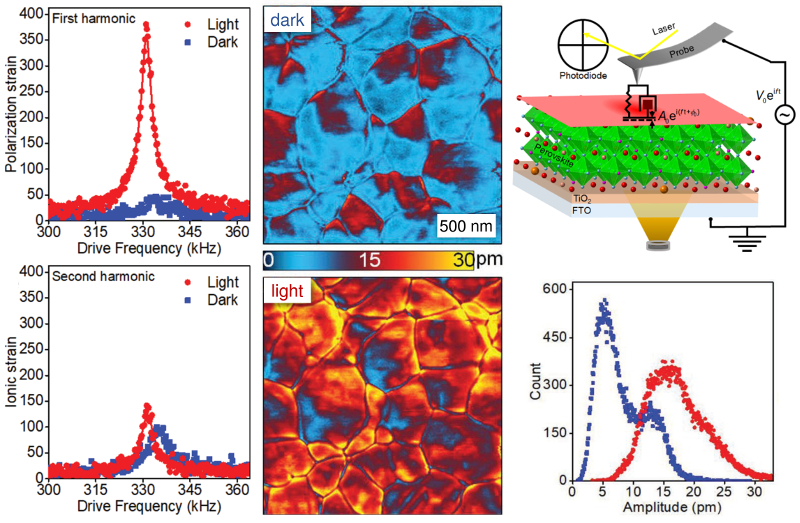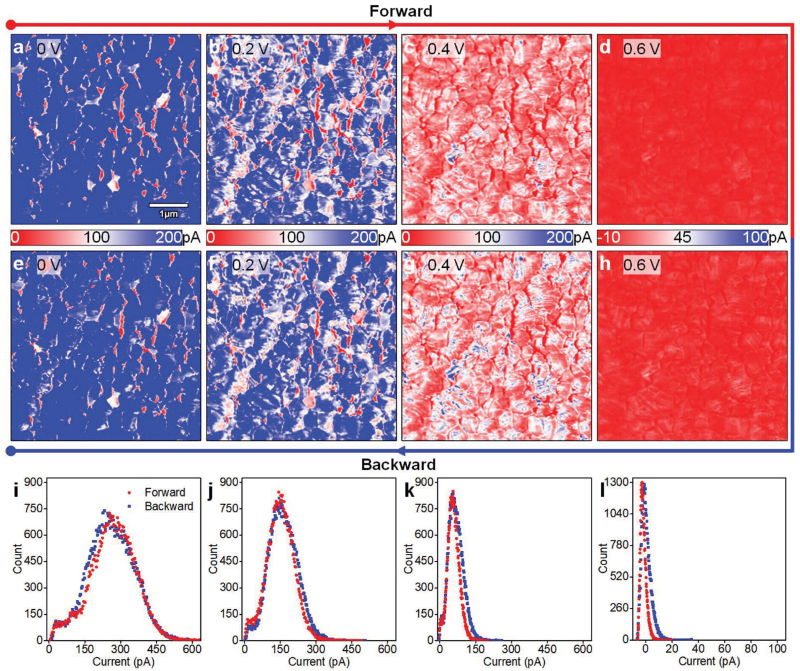AFM Systems
AFM Accessories
Learning
Contact Us
 Part of the Oxford Instruments Group
Part of the Oxford Instruments Group
U.S. and Chinese researchers used nanoscale electrical and strain-based SPM techniques to investigate photoinduced processes in perovskite materials. The results elucidate the greater and lesser roles of ion migration and spontaneous polarization, respectively, in photocurrent hysteresis.
Halide perovskite materials are exciting candidates for next-generation photovoltaics due to their high conversion efficiencies and relative ease of manufacture. However, large-scale production of perovskite solar cells requires a better understanding of current hysteresis and its impact on device efficiency and stability.

A research team from Univ. Washington–Seattle (U.S.), the Chinese Academy of Sciences–Shenzhen, and several Chinese universities has gained insight into this topic. They applied scanning probe microscopy (SPM) techniques to measure electrical and electromechanical behavior on the nanoscale in both light and dark conditions. Samples contained the triple-cation mixed-halide perovskite CsFAMA [Csx(FAyMA1−y)1−xPb(IzBr1−z)3], where FA=NH2CHNH2 (formamidinium) and MA=CH3NH2 (methylammonium).
The SPM data showed that illumination induced minimal hysteresis but strongly enhanced polarization strain. These findings indicate that photovoltaic hysteresis in ferroelectric halide perovskites is caused primarily by ion migration and not spontaneous polarization. The nanoscale information was further leveraged to construct a macroscale CsFAMA solar cell with 20.11% efficiency and hysteresis index as low as 3%.
The results establish nanoscale correlations between ion migration, polarization, and hysteresis in perovskites for the first time. In so doing, they advance understanding of photovoltaic processes in perovskites and could accelerate development of commercial perovskite-based solar cells.

Dynamic-strain-based SPM experiments were performed on an MFP-3D AFM in both illuminated and dark conditions. The Photovoltaic Option for MFP-3D Infinity AFMs provides a turnkey solution for experiments such as these that require high-resolution measurements with simultaneous bottom-sample illumination. The strain-based experiments used either piezoresponse force microscopy (PFM) or a custom, pointwise measurement of first and second harmonic response. For enhanced sensitivity, PFM was performed in Dual AC Resonance Tracking mode (DART PFM). Images of photocurrent were also obtained at different forward and reverse voltage biases with conductive AFM (CAFM) on an MFP-3D with the ORCA module. Image acquisition time was minimized by using the MacroBuild high-level GUI to automatically adjust the DC bias while continuing to scan.
Citation: G. Xia, B. Huang, Y. Zhang et al., Nanoscale insights into photovoltaic hysteresis in triple-cation mixed-halide perovskite: Resolving the role of polarization and ionic migration. Adv. Mater. 31, 1902870 (2019). https://doi.org/10.1002/adma.201902870
Note: The data shown here are reused under fair use from the original article, which can be accessed through the article link above.
